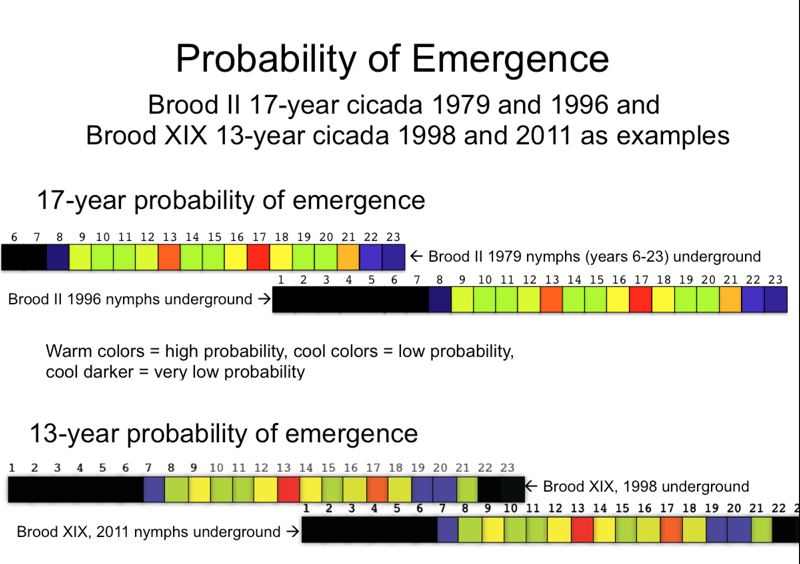People often ask: “how long do cicadas last”, “how long will the cicadas be here”, or “how long do cicadas live above ground”?
People probably ask these questions, sadly, because they are tired of listening to the love songs of these cicadas. Like the saying “it is darkest before the dawn”, however, silence is typically a few weeks away.
The length of a local emergence:
The typical periodical cicada emergence will last between 6 to 8 weeks in a single location, with significant chorusing (singing) lasting about 3 to 4. Cool weather or rain can prolong an emergence.
The research paper Emergence of 13-Yr Periodical Cicadas (Cicadidae: Magicicada): Phenology, Mortality, and Predator Satiation by Kathy S. Williams, Kimberly G. Smith, and Frederick M. Stephen1 contains a wonderful study of the arc of a periodical cicada emergence. The entire emergence event takes place within 8 weeks, from the first emerged cicada to the last dead cicada (see Fig 4 in that document 1). The number of live adults reached its peak within two weeks and then began to die off in significant numbers two weeks after that, due mostly to natural causes. After that, the population of cicadas gradually dwindles due to natural deaths and predation.
Length of the chorusing:
Male cicadas will not begin chorusing at the start of an emergence, for a couple of reasons: 1) the first cicadas to emerge, which are primarily males (Fig 3 in 1), are mostly lost to consumption by predators (Fig 6 in 1), 2) Males can’t sing until their adult bodies are fully sclerotized, and 3) they need a significant number of males present before they will chorus. That said, chorusing typically begins within two weeks 2. Males will continue to chorus until enough cicadas die to no longer sustain the chorus, which is why the chorus lasts less than a month.
Length of the emergence of an entire brood:
An emergence spanning multiple states could last between 8 to 10 weeks from when the first cicadas emerge in the South to when the last cicada dies in the North. For example, Brood XXIII began appearing the second to last week of April in Mississippi, and there were likely some left in southern Illinois up until the last week of June.
References:
1 Kathy S. Williams, Kimberly G. Smith, and Frederick M. Stephen, Emergence of 13-Yr Periodical Cicadas (Cicadidae: Magicicada): Phenology, Mortality, and Predator Satiation, (1993), Ecology, Volume 74, Issue 4 (Jun., 1993), 1143-1152
2 Kathy S. Williams and Chris Simon, The Ecology, Behavior, and Evolution of Periodical Cicadas, (1995), Annu.Rev. Entomol. 40:269-95



